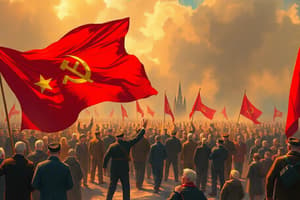Podcast
Questions and Answers
Who established the first Soviet state in 1922?
Who established the first Soviet state in 1922?
- Vladimir Lenin (correct)
- Mikhail Gorbachev
- Joseph Stalin
- Nikita Khrushchev
What significant changes occurred during the history of the Soviet Union?
What significant changes occurred during the history of the Soviet Union?
- Increased democracy
- Decreased control over economy
- Peaceful dissolution
- Expanded influence over Eastern Europe (correct)
What economic measures did Vladimir Lenin implement in the early years of the Soviet Union?
What economic measures did Vladimir Lenin implement in the early years of the Soviet Union?
- Privatizing land and foreign trade
- Instituting collective farms and controlling foreign trade (correct)
- Encouraging industrial profits and deregulating trade
- Reducing wages and worsening working conditions
Who took over leadership after the death of Vladimir Lenin in 1924?
Who took over leadership after the death of Vladimir Lenin in 1924?
Which era saw the Soviet Union's influence and control over Eastern Europe?
Which era saw the Soviet Union's influence and control over Eastern Europe?
What effect did government interference have on the ability of many people to make a living in the early Soviet Union?
What effect did government interference have on the ability of many people to make a living in the early Soviet Union?
What was one of the consequences of the Soviet Union's victory in World War II?
What was one of the consequences of the Soviet Union's victory in World War II?
What contributed to the decline of the Soviet Union's economy in the late 70s?
What contributed to the decline of the Soviet Union's economy in the late 70s?
Which event led to the pressures for change inside the Soviet Union in the late 1980s?
Which event led to the pressures for change inside the Soviet Union in the late 1980s?
How did Mikhail Gorbachev attempt to address the problems within the Soviet system?
How did Mikhail Gorbachev attempt to address the problems within the Soviet system?
What was a significant outcome of Boris Yeltsin demanding power from the Communist Party?
What was a significant outcome of Boris Yeltsin demanding power from the Communist Party?
What was one of the defining characteristics of the history of the Soviet Union?
What was one of the defining characteristics of the history of the Soviet Union?
Flashcards are hidden until you start studying
Study Notes
History of the Soviet Union
The history of the Soviet Union spans over eight decades from its conception in 1922 after the Russian Revolution until it dissolved into 15 separate countries in December 1991. This period saw significant changes in politics, society, and economy throughout the world due to its influence and control over Eastern Europe and other parts of the globe during the Cold War era.
Early Years (1922 - WWII)
After Russia's Bolshevik Revolution transformed the country, Vladimir Lenin established the first Soviet state in 1922. He built up the new government by making peace with most groups he had fought against, instituting a monopoly of foreign trade, controlling all land through collective farms, and reducing industrial profits while raising wages and improving working conditions. In the early years, this model was effective, leading to rapid economic growth, improved living standards, and increases in life expectancy; however, government interference made it increasingly difficult for many people to make a decent living. After his death in 1924, Joseph Stalin took over leadership, and as long as war didn't disrupt their plans, they continued their effort to build Socialism.
World War II Era and Resurgence
During World War II, the USSR suffered heavy losses, including nearly two million men killed by German bombs and shells, more than six million dead from disease, famine, and cold, plus another three million soldiers who disappeared forever, leaving behind millions of widows and children without fathers. However, the Soviet Union emerged victorious, having lost far fewer lives than Germany in the war but seeing huge gains in population and territory. The war also led to widespread poverty and hunger among the civilian population, despite some improvement brought upon them by the end of the war.
Postwar Period and Decline
Post World War II, the economy of the Soviet Union grew rapidly, but it began to slow down in the late 70s because resources were being used less efficiently. At the same time, there was growing discontent within the population due to increased restrictions on personal freedoms. The situation deteriorated further when Leonid Brezhnev became leader, causing a marked decline in prosperity, lax discipline, decreased work efficiency, and poor political management. In response to these problems, Mikhail Gorbachev introduced policies aimed at reviving the Soviet system, which ultimately failed to stop the breakup of the Soviet bloc that started with Poland and Hungary in the mid-1980s. The fall of communist East European governments resulted in pressures for change inside the Soviet Union itself, culminating in the August 1991 coup attempt, followed shortly afterward by Boris Yeltsin demanding that the Communist Party give up power. On Christmas Day in 1991, President Yeltsin declared the Soviet Union officially closed.
In conclusion, the history of the Soviet Union is one of dramatic changes, both social and economical, and saw several leaders come to power,each implementing different strategies towards developing Communism. Despite initial successes and periods of prosperity, the regime eventually faced internal strife and external pressure, ultimately resulting in its demise.
Studying That Suits You
Use AI to generate personalized quizzes and flashcards to suit your learning preferences.




